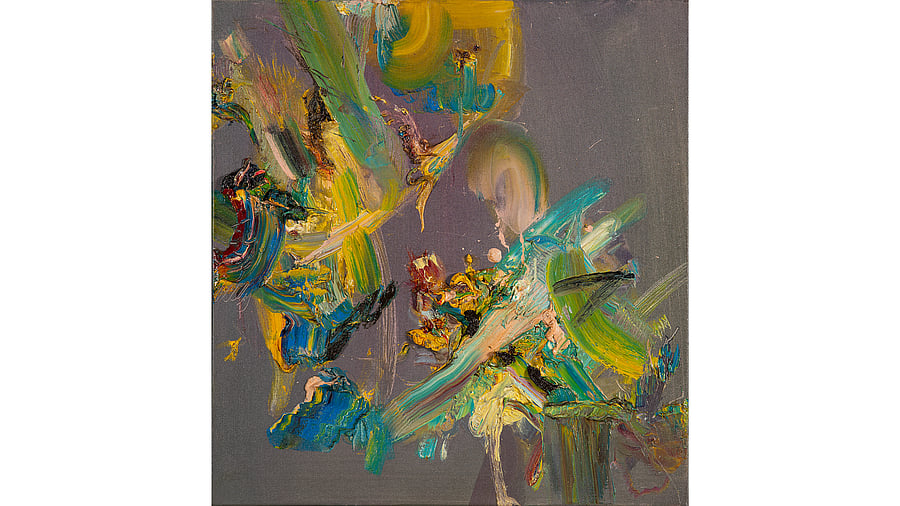
One of Raghava's works.
Life has truly come a full circle for Raghava KK, who began his career at Ashvita’s in Chennai over two decades ago, and now returns to the space for his much-anticipated solo exhibition ‘Figuring the Edge’. With this show, the celebrated artist, known for his multidisciplinary practice that spans painting, digital media, and technology-driven art, returns to the physical canvas, unveiling a series of abstract oil paintings that he calls “unphotographable”. Delving deep into ‘the Edge’, a metaphor for identity and creativity, Raghava invites viewers to encounter his latest works in person rather than consume them through screens. Excerpts from an interview
This is your first solo show in India in two decades...
My journey began with Ashvin Rajagopalan at Ashvita’s in Chennai in 2003, when both of us had just returned from New York — young, restless, and brimming with ideas. Our early shows were exciting and full of promise, and those memories remain vivid. After that, I spent nearly two decades in New York, exhibiting in India only occasionally, mostly in Mumbai. To return to the south now with a body of work I’ve been developing since 2020 feels deeply personal. It’s my way of reinventing my relationship with painting itself. Life has, in every sense, come a full circle.
‘Figuring the Edge’ is an intriguing title. What does it mean?
I have always believed that artists play a vital role in pushing the boundaries of society. With that in mind, I have used ‘the Edge’ as a metaphor for transformation; a space where the lines between the inside and the outside blur and eventually collapse. If you look at some of the greatest movements in art, they have all emerged from the edge. This show explores that emotion: what does it feel like to live on the edge? What is the edge? How is the edge a powerful metaphor for movement, growth, transformation and change?
It also touches upon what happens when the edge becomes the centre, as we have seen with rap or grunge music, which began as a cultural phenomenon many decades ago and went on to become mainstream. As someone who believes he lives on the edge, I am giving the edge a form and attempting to figure it out myself.
You call your works “unphotographable by design”, with some even placed close to the floor. What inspired you?
I wanted to create paintings that are like people. Sure, you can photograph a person and make him or her look good for any app. But it can never replace the original experience of meeting that person. Often, the closer you get to someone, the more you see their flaws, confusions and anxieties. These works are created to reflect this dynamic. They are constantly shifting as they are made with thick impasto layers, with the painting leaking onto the edges. This invites viewers to move around them and inspect them from different angles. The closer you come, the more chaos you will see.
There’s a lot of talk about AI “stealing” art or replacing artists. As someone who has been one of the first to use technology creatively, how do you view these controversies about originality and copyright?
I think it’s an exciting time. Sure, we can look at AI from an existing model and say, ‘This is copyright infringement’. But if you are wise, you would also ask: ‘Why does copyright exist in the first place? Does it make sense?’ We only think about how man invented tools, but never about how the same tools also made man. For instance, I invented the pen, but how did the pen reinvent me? It gave me math and geometry, which in turn allowed me to create urban design and put me into boxes.
Any change to society, whether it’s the pen or the printing press or AI, brings a loss of jobs, identity and originality. But it also brings along a sense of liberation and mystery. It opens up exciting new possibilities. The question then becomes, how do we want to grow? You can embrace the fact that you don’t know who you are going to become and explore yourself beyond who you already are. ‘The Edge’ is like that; you don’t know which side you are going to choose, and that’s what makes it thrilling.
Many young artists look up to you as a pioneer in digital and experimental art. What advice would you give them about staying original in a world full of algorithms and trends?
Embrace loss, liberation, and mystery because this is not a winning or losing game; it’s a growing one. Ask real questions, not the boring ones which are driven by loss or fear. Of course, those get attention and create headlines because our nervous system is wired to look for things that might go wrong. But when you develop a sense of curiosity, exploration and love, you rise above all that. Artists should keep reinventing themselves and learn to see the world through different eyes.
‘Figuring the Edge’ is on view at Ashvita’s, Chennai, till December 15.